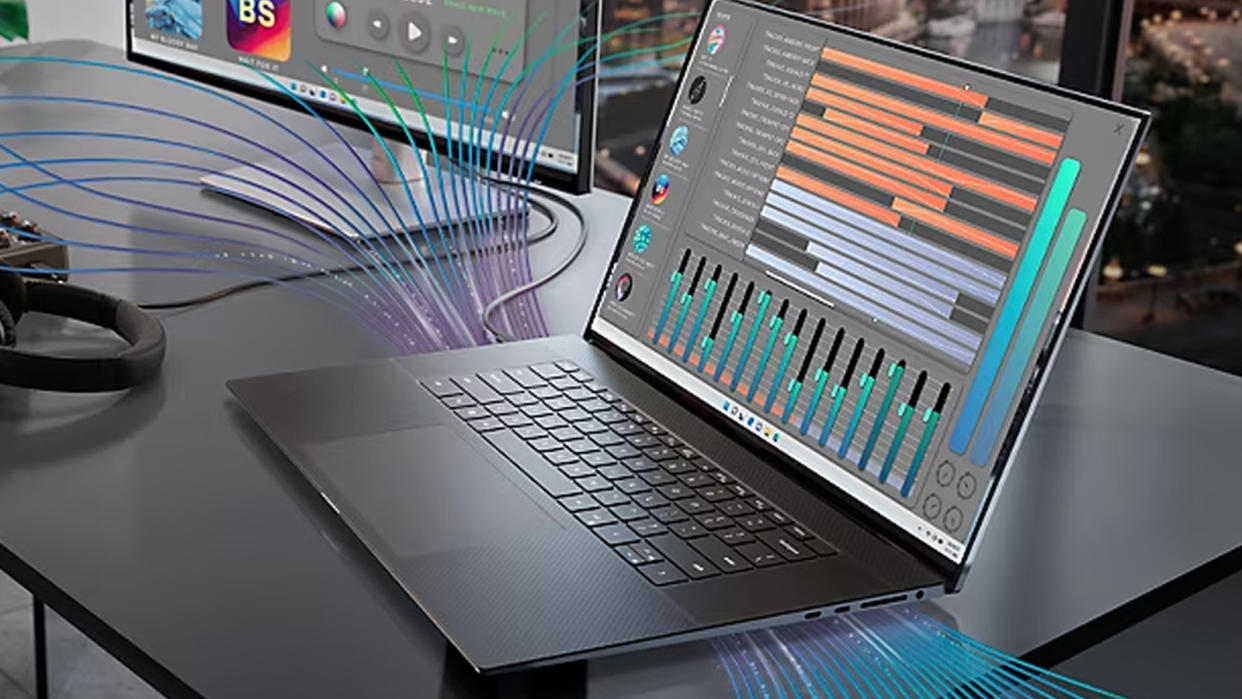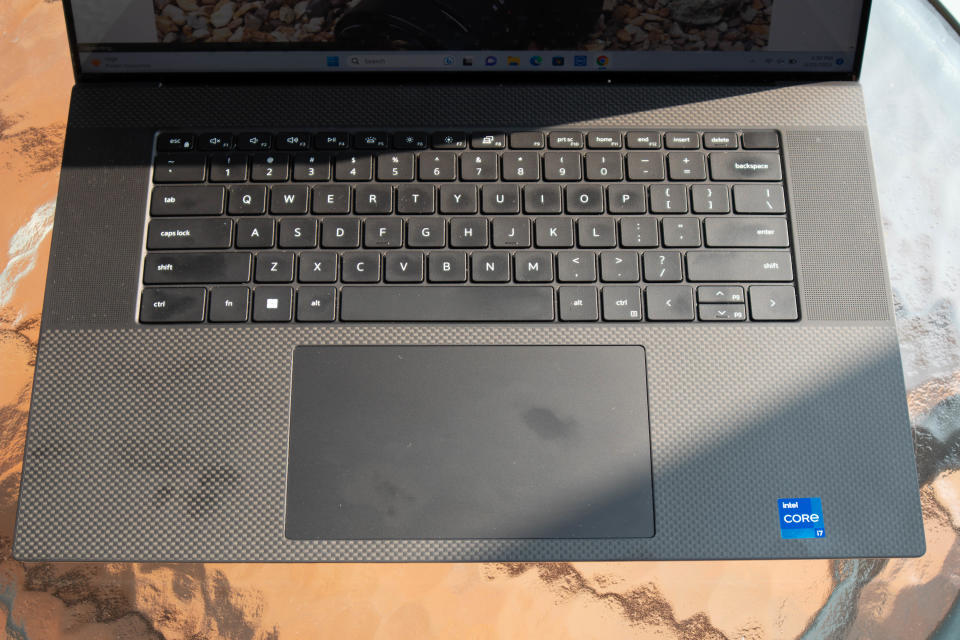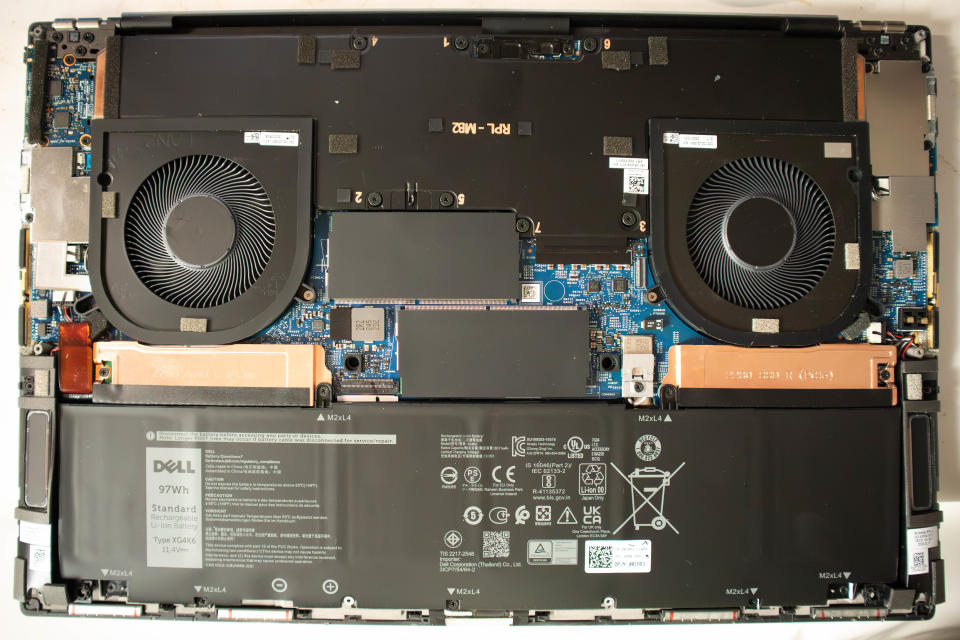Dell XPS 17 (9730) review: power over portability

When you hear the word ‘laptop’ you expect something that, y'know, fits comfortably on your lap. With its 17-inch screen and just over 2.4kg (5.3lbs) weight, that’s unlikely to be the case with the Dell XPS 17 (9730). However, that added bulk has given Dell the freedom to stuff some incredible performance into this machine.
With 32GB of RAM, a 1TB SSD and Nvidia GeForce RTX 4050 GPU, you shouldn’t have to worry about much in terms of everyday use, and can even venture into gaming laptops territory without many issues. But is it worth the money, and will it challenge the best laptops of today? Let’s find out.
DELL XPS 17 (9730): PRICE & AVAILABILITY
The Dell XPS 17 9730 is available now, starting at £2,173/$2,499/AU$3,998 with an Intel Core i7-3700H processor, 16GB of RAM, Nvidia GeForce RTX 4050 GPU, a 512GB SSD, as well as 1920 x 1200 resolution screen.
The review unit I tested costs £2,974/$3,349/AU$5,500 with the Intel Core i7-3700H processor, 32GB of RAM, Nvidia RTX 4070 GPU, 1TB SSD, and a glorious 3840 x 2400 display.
Check out T3's Dell discount codes to see if you can save on your purchase, as there are often some good deals to be had.
DELL XPS 17 (9730) review: Design & Display
It’s deja vu all over again with the XPS 17 (9730): the exterior of this beefy laptop is unchanged from 2022's model, the XPS 17 (9720). That’s not a big problem because it’s a great design, packing a lot of features into a case just 19.5mm (0.77in) thick.
You still get the same machined aluminium case, Gorilla Glass screen cover, and carbon fibre palm rest package, but with a slightly increased 2.4kg weight. That’s a lot to lug around, and you’ll feel the density of this thing when you pick it up, especially when you include the hefty 130W USB power adapter. But if you want sleek and light, get a Dell XPS 13 – as this larger 17-inch model on review is about power over portability.
There are plenty of upgrades under the sleek exterior, though, with a 13th Gen Intel Core i7 processor with 14 CPU cores. There are two options: the i7-13700H maxes out at 5Ghz, or the i9-13900H ups the maximum speed to 5.4Ghz. Intel’s somewhat confusing naming system aside, the two processor options are pretty much identical except for the maximum speed, offering 6 performance cores and 8 efficiency cores. That provides 20 logical processors or threads, the basic units that the system can assign to a task.
The screen on my review unit was the more expensive option, a Ultra-HD panel display with a tiny sub-4mm (0.15in) bezel around the edge. This display looks great, with vivid colours that pop off the screen and deep, dark blacks. It does lack the bright colour and deeper blacks of OLED displays that are showing up on gaming laptops, though, and is also limited to a 60Hz refresh rate: you don’t get the smooth motion of high-frame-rate gaming here, although this laptop plays a decent game of Doom Eternal. If you want to save a bit of cash (and extend the battery life), Dell also offers a Full HD (1920 x 1200 pixels) option.

The graphics processing unit (GPU) that drives this big screen is an Nvidia GeForce RTX 4070 with 8GB of dedicated DDR6 video RAM. That’s in the middle of the available range, from the RTX 4050 with 6GB of video RAM to the RTX 4080 with 12GB. Whichever option you choose, get ready to be warm, as these GPU can use up to 60W of juice: nearly as much as the processor itself.
Because of those pesky laws of thermodynamics, all that energy has to go somewhere. The XPS 17 (9730) uses a vapour chamber cooling system and two fans to vent the heat, sucking air in from the grille on the bottom of the laptop and pushing hot air out of the vents between the base and the screen. This does a pretty good job: most of the time, you hear nothing but a slight hum from the fans.
However, the fans get a little noisy when the CPU and GPU are working hard: the sound rises to a dull roar. It never reaches the attack-helicopter-overhead noise of many gaming laptops, though. The Dell's case does get a bit warm as well – as after a long session or number crunching I measured it at about 55C (130F) on the edge of the base next to the screen and the bottom of the case.
The large, widely-spaced keyboard is comfortable to use, and the equally expansive touchpad under it is nicely sized for easy use. The black carbon fibre material surrounding both does keep the weight down, but I found it showed fingerprints and cat hairs rather too easily. Two big speakers on either side of the keyboard produce bright, clear sound with plenty of bass and good stereo separation.
DELL XPS 17 (9730) review: PERFORMANCE & FEATURES
The XPS 17 (9730) is a fast machine by any measure: I found that it could handle video and photo editing, huge spreadsheets, and 3D modelling without breaking a sweat. It’s not a gaming machine, but it did a decent job running several modern 3D games at or near the maximum 60fps that the screen can handle.
In the PCMark 10 Office benchmark, the XPS 17 (9730) managed a very respectable score of 7607, which is a 7% increase on the previous XPS 17 model. That’s not a huge increase, but it aligns with what we’ve seen from upgrading 12th to 13th Gen Intel processors: more of a performance bump than a quantum leap.
This speed increase was reflected in my tests: programmes like Adobe Photoshop and Premiere were very usable. I could apply a filter to 4K video in Premiere and usually get a real-time preview of the result. The same was true in Photoshop: the XPS 17 (9730) has no problem working on very large images with multiple layers. That’s probably partly due to the 32GB of RAM in my review unit, but the processor didn’t seem to be holding it back, either.

The gaming benchmark 3D mark recorded a score of 9618 in the Time Spy test, which is at the high end of the scale for non-gaming laptops. This was borne out in my experience running 3D games like Doom Eternal, which ran between 50 and 60fps at the Ultra Nightmare graphics setting at the native resolution of the display.
F1 22 is a bit more demanding, running at 14fps at the native resolution in the highest graphics mode. When I reduced that to Full HD the frame rate rose to a very playable 50fps. So while the XPS 17 isn’t a gaming machine, my review unit could still handle its own in modern games.
One area where the XPS 17 (9730) doesn't excel is battery life, which in my tests was adequate when doing general work, and very poor when playing a game or editing video. Using the PCMark 10 battery test, I found that it lasted for 5 hours and 22 minutes, running the benchmarks mixture of web browsing and a bit of spreadsheet work. That time was significantly shorter when I tried something more arduous: I only got about 50 minutes of Doom Eternal out of the 97Whr battery and about an hour-and-a-half of running a complex spreadsheet.
DELL XPS 17 (9730) review: VERDICT

The XPS 17 (9730) may be a bulky and heavy laptop, but its exceptional performance, expansive and bright screen, and generous storage capacity cannot be denied. Whether or not its size is worth the extra weight ultimately depends on your needs.
Do you need to be running power-hungry tasks like 4K video editing on the road? It’s way too much computer if you are just doing a bit of web browsing, word processing, or other lightweight tasks – as the smaller Dell XPS 13 has more than enough power and is much lighter.
If you require a computer that can crunch numbers and show the result on an attractive 4K screen, then the Dell XPS 17 (9370) is a great pick for 2023, as long as your shoulders (and credit card) are up to the strain.
Also consider
If your computing needs are more modest, you can’t go wrong with the XPS 13 or the XPS 15. The latter offers a great balance of biggish screen and processing power, but without breaking your back (or bank balance quite so much).
If the big screen is the main thing you need, consider the LG Gram 17. This slim model feels featherweight compared to the XPS 17 but offers similarly extensive screen real-estate.
